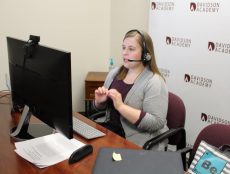
Articles
Editor’s Picks
Higher Education
K-12
Coronavirus Has Arrived. Will an LMS Be Enough for Remote Learning?
By Henry Kronk
March 12, 2020
In the early months of 2020, coronavirus, also known as COVID-19, surged in China and surrounding countries, leading to large-scale school closings. The virus has since spread around the world and has arrived in the U.S.
On March 11, the World Health Organization declared the outbreak a pandemic. No one knows how far, wide, and long coronavirus will spread. While young people—especially children—tend to handle the virus far more effectively than older patients, closing public institutions like schools where many people mingle on a daily basis has been seen by some as an effective way to combat the spread of the illness.
Many Schools Have Already Closed Due to Coronavirus
Many K-12 schools and colleges have already closed and moved classes online. On March 10th, Harvard, MIT, Michigan State University, Cornell, Syracuse, Rutgers, and American University canceled in-person classes. The number is likely to grow.
K-12 schools have also announced coronavirus-related closures across the country.
While the decision to close schools is controversial for some—and must be weighed against the impact that it will entail—it’s likely that education stakeholders who live and learn in areas that experience outbreaks will face school closures of some duration.
But just because school is closed does not mean learning needs to stop. Using technology like learning management systems (LMS), video conferencing software, email, online libraries and databases, and more, instructors can continue to teach lessons from their homes.
Some schools have been prepared to deal with extended closures for years, usually in response to severe weather events. Some have prepared in the past few weeks. But for many students, parents, teachers, and administrators, coronavirus closings might be their first experience with extended remote learning.
We reached out to a handful of remote learning experts, schools, and edtech developers to get their advice on how best to deal with extended coronavirus closures. This post marks the first in a series of three.
https://twitter.com/motheroftheses/status/1237425331746701312
Many schools already use learning management systems (LMS) as part of their teaching process. This technology can allow a good deal of remote communication between teachers and students. But will it be enough?
Coastline Community College Dean of Online and Innovation Shelly Blair and Vice President of Instruction Vince Rodriguez:
A Learning Management System (LMS) is a great tool for supporting online instruction. However, it can take time to learn how to effectively use an LMS. The key for instruction that is moving from face to face to online/remote is going to be flexibility.
Associate Professor of Educational Psychology and Educational Technology at Michigan State University Christine Greenhow:
Using a Learning Management System (LMS) like Blackboard will not be enough. To fully engage students in remote teaching and learning, educators cannot simply take an existing class and put it online; effective remote teaching and learning requires revisiting your goals for students’ learning and classroom culture and considering how using the online technologies available to you can help you meet, or even re-imagine and improve on those goals.
For instance, maybe your goals are to give students multiple opportunities to practice skills they need to be successful in future work places—skills like collaboration, public speaking, writing, and socio-emotional skills like establishing and maintaining positive relationships—all within a fun, cohesive, and supportive classroom culture.
Realizing these goals online can be extremely challenging when using only learning management systems, which are largely text-based, centrally controlled, and stripped of visual, auditory, and other social cues as well as the participatory culture in most classrooms.
Don Weobong, Founder and CEO of Telania and eLeaP:
Remote teaching and learning certainly has a huge role to play in normal times but in the present situation with coronavirus, it can play an outsized role. The question about if it will be enough is one that is a bit tough to answer. A component of learning is social interaction and that can be reduced with an LMS approach. However additional video conferencing tools can mitigate this somewhat. Of course, with every tool there are advantages and disadvantages.
Scott Kinney, President of K-12 Education, Discovery Education:
I think what’s inside the LMS is critical. If a child is kept home from school for an extended period of time and they are working on a series of worksheets, I’d think their overall engagement in learning will be low. With all the distractions students have at home, I think it is more important than ever that they have access to high-quality digital content.
When it comes to remote teaching and learning, educators will need support navigating the shift from teaching in a classroom to teaching in an online environment.Professional Learning Networks, like the Discovery Educator Network and others, provide spaces where educators can connect with one another and share research-based instructional strategies and lesson plans, timely content, and ideas on any teaching topic, including teaching in a virtual environment.
https://twitter.com/DiscoveryEd/status/1235564546128932865
Brandon Martinez, Director of Learning Development of Noodle Partners:
No. There still needs to be some mediation of learning between peers and teachers and peer to peer. An LMS is a tool to provide access to a range of content and assessments, but learning doesn’t happen in isolation. Even if the interactions happen asynchronously, it is more effective than just a place that holds course content.
Russ Chadinha, Senior Director, Product Marketing at 8×8:
Learning management systems are great tools that help teachers organize content, enable students to collaborate, and support technology learning objectives. But, students still need new topics and materials introduced and modeled, reinforced through questions and discussion, so they have the fundamental knowledge elements needed to use the information. Learning Management Systems are not able to effectively deliver lessons this way. So, whether in a classroom or through remote learning, teachers need a way to deliver these lessons.
One of the interesting dynamics of remote learning is the change in scale, even for self-contained classes. For example, a teacher may have four math classes each day. If there are 28 students in each class, the teacher is giving the same lesson, 4 times. But, each class may be moving at different speeds. With remote learning, the teacher may only conduct 1 lesson per day that includes all 112 students. Now everyone is presented with the same material at the same time. Pacing now becomes a more acute challenge. The LMS can enable collaboration, but the teacher still needs to work with small groups along with the ability to support individual questions to ensure the content is accessible and understood.
Here’s where online video classrooms are useful. With the ability to present and model the material, supported with chat windows for questions and comments, teachers are able to set up the lesson and guide students as they work through the material. Video changes the online dynamics versus “audio only.” The connection with video is more personal and engaging, especially for upper grade levels.
What happens if your company announces a mandatory #workfromhome policy but you've never been a remote employee? Watch this short video to learn 5 tips for working remotely. https://t.co/rM7JUdYCPk #remotework pic.twitter.com/svZ1rkI84u
— 8×8 (@8×8) March 4, 2020
Carli Tegtmeier, Vice President of Sales, Higher Education at Pronto:
The one thing that teachers and students are most likely to miss in an online course on an LMS is that sense of personal connection and human interaction. Pronto allows teachers and students to stay connected, keep students engaged, and maintain a positive student experience. With remote teaching and learning, mobility and usability are of utmost importance. Pronto is built mobile-first, reaching students where they are, while also providing a seamless user experience for teachers on desktop, integrated with the LMS.
Please RT
As institutions move online in response to #COVIDー19, Pronto is now available at no cost to faculty in an effort to allow teachers and students to stay connected while they work from home.#edtech #highered #onlinelearning #RemoteLearninghttps://t.co/bCuM92yNQr
— Pronto for Education (@ProntoEducate) March 9, 2020
Disclosure: Telania owns and operates eLearning Inside.
Featured Image: Powerofflowers, iStock.









8 Comments